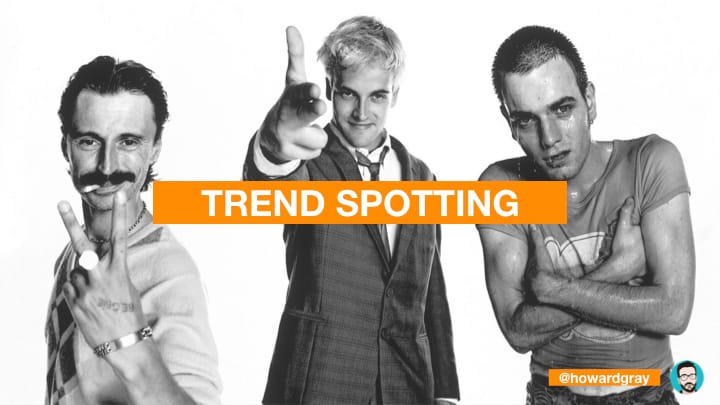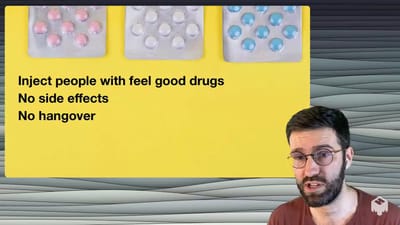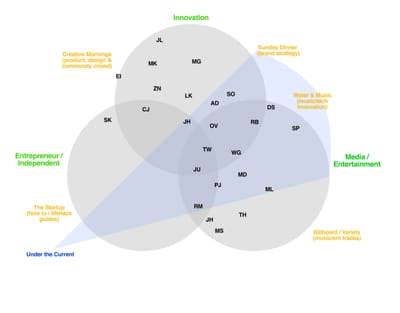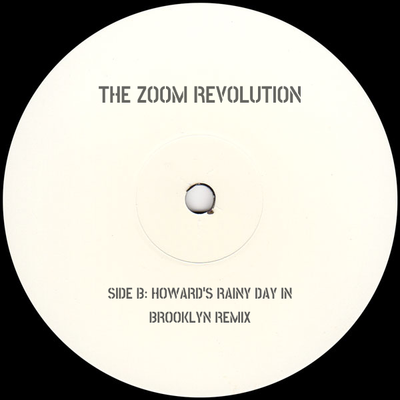Trend Spotting: How to identify what's coming next

A workshop session I designed and facilitated in Summer 2018 (annotated and abbreviated version, with some classroom exercises and notes included)
Yes, it’s that time again – I’m back with another of my annotated slide deck adventures.
This time we’re diving into Trends.
I created this short session as part of the growth & change management module of the AMP NYC accelerator program which ran here in New York City over the summer of 2018. Including the exercises it was about 45 mins in duration, and can easily run to 2-3 hours if you want to dive deeper into certain parts of the content.
At the time I ran this session there were a few blank faces in the room upon seeing this first slide up on the screen, and not just because it was another of my bad puns.
I realised this movie is now 24 years old; pretty close to the age of the younger attendees in our cohort.
It’s also, despite its international success, still very Scottish and even as a native British English speaker I still can’t decipher all the local Glaswegian parlance.
So that’s the last we’ll be seeing of Begbie, Renton and Sick Boy (for this session at least) – time to get into some Trend Spotting.
We all use the word ‘trend’ in our day to day lives, but before we can spot one it probably helps if we can define it.
It’s actually pretty tricky. Here a couple of dictionary definitions to get us going.

Adam Robinson talks about trends from this second perspective in the second part of his excellent Farnam Street podcast (note: it’s very long but worthwhile).
So we’re nodding along to these – they make sense but they’re not particularly colorful.
Let’s jump into a couple of examples.

Anyone know what this is
This trend actually started a bit earlier than most of us may think (very detailed Wikipedia article), but what’s most interesting about it as a trend is that
The first of these other trends was nostalgia, particularly for cultural touchpoints from the 80s and 90s. Nostalgia relates to our desire for familiarity, which is one of the drivers behind popularity in all sorts of fields.
The second was geo-location. This is a trend that’s been around for a while (we’ll get into the lifecycle of trends in a moment), but its now-ubiquity and much-increased accuracy is what helped fuel the growth of Pokemon Go.
And last of the three is a newer trend that’s earlier into its lifecycle, Augmented Reality (AR).
Arguably some other trends like gamification contributed too, but to my mind these are the 3 biggees that helped make Pokemon Go such a big success.
Let’s try another.

Oh yes, our old friend Bitcoin. We’re not going to spend too much time here as we’ll probably end up in an hour-long debate about the virtues of Ethereum, ICOs or CryptoKitties, but it’s hard to deny it’s a trend.
For what it’s worth, I’m more interested in blockchain as the underlying technology rather than the currencies…but that’s for another day.
Here’s a Google Trends search for ‘cryptocurrencies’ from 2017:

(for the class) What contributed to Bitcoin and/or Blockchain becoming a trend?
So we’ve covered a couple of recent trends, and the factors that may have helped them get where they have.
How we can understand where a trend is at, and where it may go? Time for a graph.

This is a Gartner (or simply ‘Hype’) curve. This is a really simple and handy way of mapping out trends of all kinds.
My personal
They’d start working with these businesses when they’d hit a low point, then bring them up the slope of enlightenment, to the chagrin of their agency competition who had invested all their resources into chasing the Peak of Inflated Expectations.
Let’s check out a Gartner curve with some stuff on it.

Here’s a hype curve from July 2017 so we can take a look at how some of these trends have played out. As you can see these are deeper technology trends (Gartner curves tend to work well for tech, but can be used for all sorts of trends)
What do you think about this? Is VR on the Slope of Enlightenment, or has it slipped back into the Trough?

Let’s head back to our template curve and apply some trends from our own industry.

So now we know a bit about what trends are, and how we can map them out, how about actually spotting them, especially early on?

Let’s ask an expert marketer.

Beth’s heuristic of 3 being the magic number is a nice easy one to remember and apply. Here’s one I’ve noticed that also helps.

Notice what you write down. All sorts of innovations have happened this way, including Charles Darwin making enormous breakthroughs in the evolution of our species. More on stationery later…
Here’s another way of spotting trends:

Chris Dixon writes a lot of good stuff about future trends, particularly in technology. I really like this way of observing the world – dozens of seemingly weird and niche things have evolved from weekend hobbies into ubiquitous tools, products and activities.
Perhaps it’s worth asking not ‘How was your weekend?’, but more ‘What did you spend your time doing this weekend?’
And this concept isn’t limited to your many friends who are multi-millionaire VCs, Nobel Prize winning professors, or Hollywood screenwriters. Inspiration of this type can come from unexpected places.

In 2009 I was living in a house share in East London. It was a pretty wild place – an 8 bedroom Georgian double-fronted house with a huge basement kitchen/living room.
The house’s previous tenants were a TV production company making an ‘adult’ version of Big Brother, featuring numerous strippers and lap dancers. To ensure maximum bang for their buck they had even installed an industry-standard dancing pole in the living room. After the show was shockingly(?!) cancelled after one season, the place came up for rent and I joined after one of the first cohort decided to move out after a year or so.
After I’d been living there a few months, one of my housemates had to go on an extended work trip and rented her room to a friend of a friend, or rather friends of a friend. Our guests were two 19 year old German girls.
Early one Saturday evening shortly after they moved in, I was watching some sort of dross on TV and noticed them engrossed in their phones (this was rarer then!).
It turned out they were watching music videos on YouTube. Or rather they were listening – there was no video, just a sketchy looking JPEG overlaid as a tile for the audio. I thought this was pretty weird, and saw them scroll through all sorts of weird and wonderful YouTube channels I’d never heard or seen of, accessing bootleg remixes of big pop hits alongside the big hits themselves.
Given my pedigree in the music industry, I did what you’d expect.
Nothing.
It was only 9 months later when I saw the team in my own company sign artists directly off the back of their YouTube and Soundcloud heat did I
However, not every trend lasts like this one. It’s worth asking ourselves how long lasting a trend is going to be. Remember this YouTube music sensation?

How can we figure this out? It’s not easy and definitely not an exact science but here are a few factors we can think about:

This framework is also helpful to keep you on track – as business owners it’s easy to get caught up in the shiny and new like the magpie.
Or even simpler, use these 3 R’s:

Before we jump into another exercise, let’s take a look at 3 other factors that help us better understand, see and harness trends.

2nd and 3rd order effects are a very powerful force to be aware of – and not just in trends but in all sorts of areas of our work and our lives.
Let’s take the example of education and specifically a previously occurring trend (in some countries at least) towards subsidized education.
Note: This example can cause
For the sake of time we’re going to simplify this – it’s a complex topic but this example should give you a good feel for how 2nd and 3rd order effects can be powerful, and unexpected.
One of the factors that enabled subsidized education to happen was the increased supply of credit.
The first order effect of this was that people who previously couldn’t afford to go to college now could.
What happened next was that institutions kept putting their tuition fees up. (if you’re interested in this there’s a monster blog post by Conrad Bastable explaining how college financing works)
The second order effect here was student debts increasing.
And what do you think the third order effects have been?
Certainly economic issues, a large number of colleges becoming squeezed, and also perhaps the rise of new companies and business models like the AltMBA and Lambda School amongst others.
How about something smaller scale and more relevant to us as entrepreneurs?

This is McNally Jackson’s ‘Goods for the Study’ store in the stylish Nolita district of NYC.
It only sells writing instruments. Pens and pencils. That’s it.
I was here last week with my wife. As she was browsing for a couple of new pens, I found myself thinking about what caused this shop to exist.
Perhaps this new business came to be in part because of our fatigued feeling with social media? Our desire to create new things by hand? And as one of the class pointed out, there are a few new suppliers of typewriters popping up – another signal that a new trend could be coming.
Going back to our desire for familiarity – things that get popular often have that sense of new wine aged in old oak.
Here’s a related thought – 2rd and 3rd order effects can apply to competition too.

Why the Roman ruins?
A few weeks ago I was working with a large technology company, helping groups of some of their top engineers to tell more compelling stories.
One of the storytelling techniques we talked about was metaphor. The group in question were trying to convey how strongly they felt about seemingly distant competitors becoming rapidly more dangerous.
Over the course of a couple of hours I helped them translate their pie charts and white papers into stark imagery and stories that their detailed research (or rather battle plans) could back up.
They chose this image as they both loved history, and felt their company could be the Roman Empire at risk of decline, with the hoard of uncouth Barbarians coming quickly from afar to take everything they’d worked so hard to build but had recently become a little complacent over.
These modern-day Barbarians weren’t first order competition, they were in fact 3rd, only being able to mount an assault because of the knock-on effects of other things our Romans had unwittingly done.
We can illustrate this in another way, more akin to our own industry of Media & Entertainment:


Not Amazon, not wine (although that’s a good guess).
It’s sleep!
And on a related note, VOD is likely a very long lasting trend.
I promised another hands-on exercise – here it is.

Use post-it notes or another quick and dirty way of brainstorming ideas.
After 5 minutes, start collating all your ideas into themes, with those 2nd and 3rd order effects attached.
What did you come up with?
We’re nearly done. Let’s take a quick look at some resources we can use. We’ve already mentioned Google Trends, here are a few others:

JWT’s Intelligence emails and decks have lots of useful material, particularly from a branding and marketing perspective.
Protein are a London-based trends agency focused on millennial consumers.
SpringWise is a weekly email digest and membership network looking at new innovations, particularly in sustainability and for-good initiatives.
Reddit is always worth a dig through if you’re brave 🙂
Product Hunt is mainly focused on digital products, but plenty of innovative ideas and bleeding edge trends here.
Finally, on the tech side, Mary Meeker’s Trends deck is worth skimming, as is this list from SupplyGem.
There’s plenty more we could get into here, but in summary here are a few key things to take away:

And remember:

Here’s to you continuing to Trend Up.
Thanks!

No spam, no sharing to third party. Only you and me.




Member discussion